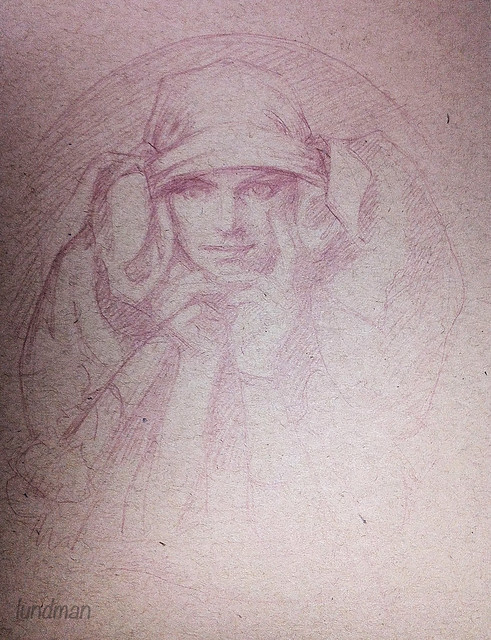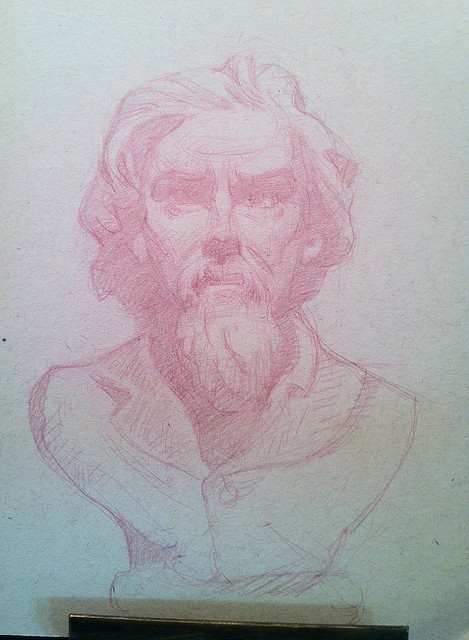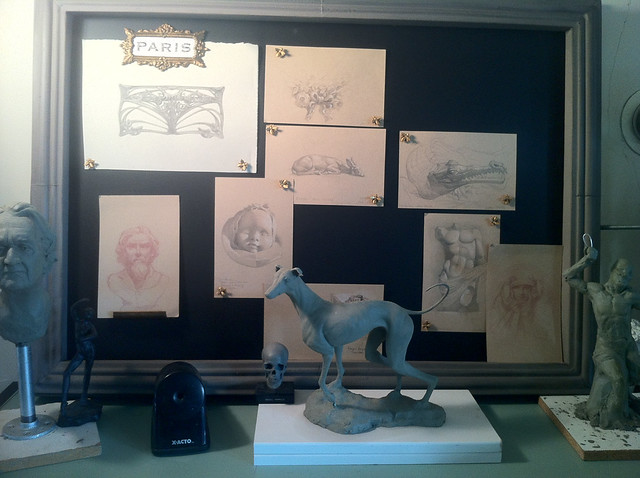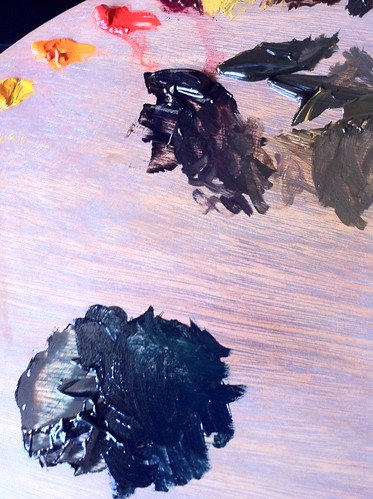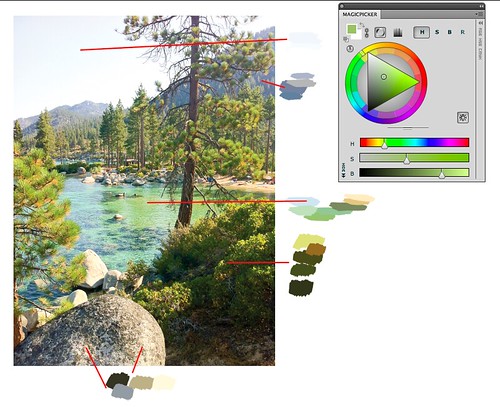CTN Expo in Burbank and new website updates!
Hey friends! I will be attending the CTNX animation expo in Burbank, California this upcoming weekend in order to show my portfolio, get some much needed feedback, meet up with friends, go to lectures and geek out over all the awesome art! Here are a few highlights from my portfolio. Although I am in the midst of working on a couple of story projects, I put together this basic portfolio with highlights from those projects (still so much more to come) and a couple of images from my game experience. I'm going to the expo with the intent of getting some feedback on the personal work so that I can focus for the next few months on what I need to accomplish.











"Stubble Trubble", independent short film project
In the late 1990's, I worked on a short independent animated film at Calabash Animation called, "Stubble Trubble", directed by Joe Merideth. At that time, the studio had a steady stream of commercials that kept almost all of us very busy throughout the year, but on occasion there would be a lull in the schedule. During that time, we always had short films to work on. "Stubble Trubble" was one of two indy films that I art directed, and what a learning experience it was!
Below are a few samples from the mountains of visual development pieces I created for "Stubble Trubble". In the end, the film toured the short film festivals all over the world and was even nominated for an Academy Award in the short animated film category in 2001. After all of that hard work, it was amazing and so satisfying to have been recognized for the effort we made in making this film.

Because Director Joe Merideth specified that he would like "Stubble Trubble" to look like animated cave paintings, I felt that a color script was necessary so that the film didn't become too monotone. The pencil tests that Joe developed at this point were full of energy and action, so I wanted to make sure that each scene was emotionally heighted by texture, lighting, and color in order to make those scenes feel dramatic. I had to balance the cave painting look with something that felt alive and kinetic. I developed a color script for the entire film, experimenting with how one scene's design would flow into the next and whether or not the lighting and color design worked scene to scene.
Once the script was approved by Joe, I was able to move forward with background texture explorations, line work development, lighting and compositing. The color script was the frame work for the entire film all the way to the final edit.

After I developed several visual development look paintings, I began working on the line work clean up look. I used one of Joe's scenes from the pencil test to develop a complete scene using this line work process to test whether it would work frame to frame. It did, so I developed a model packet and process for clean up and then trained the crew in the process. I even filmed a short clean up process video so that the animators could refer to it when needed.

Above is a still from the final composite. We tested out how this would all come together in one scene to make sure this was a producible film. Joe, my director, was happy with the look so we moved forward with the final fim production. Below are a few more still from the final film.

"Stubble Trubble", directed and written by Joe Merideth. Produced by Calabash Animation. Art Direction by Julia Lundman. Animation was entirely done by all of our amazing animation staff at Calabash.
THE TIME MACHINE: Visual Development with Armand Baltazar/Animation Collaborative
I recently took a visual development course at the Animation Collaborative taught by senior visual development artist Armand Baltazar, who has worked for many years in animated film, with credits on Dreamworks, "Shark Tale", "Spirit", and "A Bee Movie", as well as Disney's "Princess and the Frog", and more recently Pixar's "Cars 2", among many others. Of all the classes I've taken in recent years, I found this course to be perhaps the most exciting. I've always been deeply interested in visual storytelling, although I've not always had ideal opportunities to practice that very fine art to the fullest I've wanted. So when Armand's course came up on the roster and time in my schedule allowed, I jumped. Aside from my own interests, I feel a good visual development class is an excellent experience for any artist at any level to go through. So many of us have grand ideas around stories, world building and stylization, but how many of us have really gone deep into our visual storytelling skills? If you've not had the opportunity to take such a class, I encourage you to find one or else pick up a few good "art of" books for film, games, and television.
Regarding this specific class at the Animation Collaborative, I felt it was absolutely worth it. Armand was a fantastic teacher and really put in a lot of extra work and effort in teaching the class, even staying late to give back really valuable individual feedback, paint overs and advice tailored to each student. Each class was chock full of fantastic information about visual development, portfolio development, and tips and techniques for working quickly, as is required on any project in development.
For the class we each picked a classic book to visualize as an animated film. I picked HG Wells', "The Time Machine", a book that I illustrated years ago, but unfortunately didn't do a very good job of it due to the extremely rushed deadline. For years now I've wanted to revisit the story, and have imagined a reboot tailored toward an animated young adult film. I thought I'd share my character design concepts here, and later will share more development. Over the course of the next year I'll be working up ideas around this story and will share more as I solidify ideas.
***********************************************************

My Time Traveler in my reboot of "The Time Machine" is a young woman in present day. When I draw character sketches, I like to keep a very, very simple line with almost no detail. I like to save any modeling or texturing for painting. I really enjoy the challenge of trying to capture a gesture in as few lines as possible.

I envision the Time Machine device to be wearable tech made up of everyday things like hacked ipads, iphones and a laser tag vest. Like in the original book, the time machine does not move the individual through space, but only through time.


Imagine what happens to those digits after thousands and thousands of years of swiping/touch technology… I enjoyed working on my take on the ELOI quite a lot. I envisioned them growing tall and thin with elaborate hairstyles and lots of adornments.


The Morlocks live in underground caves where they have evolved eyes that allow them to see in the complete darkness. They live amongst the ruins, pollution and grim of thousands of years of human corruption.

Below are some quick color comps and sketches of what I have been developing around story moment ideas. Most of these are pretty quick, like 2 hours each or even less in the case of sketches. All of these are meant to be exploratory in nature, and will eventually become more finished paintings. I can't wait to work on these!



I've long been a fan of Douglass Trumbull, well known in the film industry for his innovative special effects on movies like 2001: A Space Odyssey, Blade Runner, and Star Trek: The Motion Picture. I wanted to emulate his effects in some way, and have envisioned the bottom row of images to be my take on time travel effects.

This is my quickie version of a future city, although I have plans to iterate on this a bit more. Given that our class was only 12 weeks and I only had the weekends to work on it, I felt that I didn't have enough time to really dig through this juicy subject. Looking forward to exploring some more concepts!

Hey, who doesn't need a hot Eloi boyfriend in the future? Actually, this is one aspect of the story that I am quite excited about: the friendship between The Time Traveler and Weena, in my version female (time traveler) and male (eloi). I think this can be resonate with the story themes in some unusual ways - I'm so excited to work some more on these ideas.
I actually have a number of additional sketches and comps, but they are still a little too compy to share. Hopefully soon!
As I continue to develop my ideas I will post. I hope to put a little book together by sometime next summer, if all goes well.
Thanks for reading!!!
My Latest Studio Work/Progress on Final Color Pass
First session after finishing the initial color block in stage. I spent most of this session looking at the value relationships between the white of the vase (which was really a very warm-grey), the white of the board the entire set up is sitting on, the white of the flowers and the white of the butterfly. I spent a good deal of time in this session comparing between the four white areas, trying to see what the difference between them was.

I focused first on the flowers. In the first color block in, I felt that the shadow areas were getting a little too dark and muddy, when what I wanted was luminous colors even in the shadow areas. I painted over all of the shadow areas of the flowers and strengthened the white areas. I also pumped up the contrast on the yellow flower stamens.



**************************************************
Second session of the final color pass:

The focus of this session was on the butterfly held up by twine. The butterfly is made of white feathers, paper mache in the body, and has iridescent glitter all over the wings, making it a difficult challenge.
Sadie suggested that instead of painting each and every little dot of glitter, that I paint large swaths of blurry color - the shapes of the areas instead of pieces. I also remembered a passage in James Gurney's book, "Color and Light" about painting scales on a dinosaur. Instead of painting all of the texture everywhere, he recommended only painting the texture in the light, and especially in the highlighted area. As the textures moves into less illuminated areas of the form, it will become less and less apparent to the eye.
This was as far as I chose to push the glittery iridescent areas of the butterfly. In the next few sessions during the final pass I will revisit both the glitter areas and the string.
**************************************************
Third session of the final color pass:

I spent almost this entire session working on the pattern on the vase and the color shifts in the shadow areas of the white areas in the vase.
I often struggle painting white objects. As I am observing the scene in front of me, I can clearly see the light area vs. the shadow side. But when I've sat and observed these same objects over a long period, like today's five hour session, my eyes begin to pick up the subtle hue shifts, bounce colors and variation in the value.

In the past when I'd worked in the alla prima method (direct wet on wet painting) I would just simplify these areas for the sake of turning the form, with the brush work always on stage, so to speak. The Flemish indirect method, on the other hand, provides the opportunity to get the subtle variance of the light on the form by building up layers and layers of paint. With layering, you can push and pull areas into and out of focus, glaze areas, and continue to soften or sharpen edges endlessly. All of this makes it challenging to make decisions. I've resigned to working out the "mood" of each area in relation to the whole piece.

For the final finishing details in the next 2-3 sessions, I plan to work on the gradient of the blue-green in the background. Working over many sessions, the color in the background has begun to creep a little. Some areas are not matching previously painted areas. That happens because each session I am working on a specific area and need to mix up the surrounding background paint color so that I can soften the edges.
In the next few sessions, I will work on smoothing out the hue shift and the shadow areas so that it is a little more harmonious. I might also make the green-blue a little more saturated. The flowers still have a few textures and details that are not yet depicted, and the glitter on the butterfly is not quite there yet. Last but not least, the pattern on the vase…is it too dark? I will most likely add a light glaze of vase color on top of the pattern in the center so that it does not call itself to attention so much.
Thanks for reading!
iPad sketch videos
My partner, James Baker and I have been sketching lately from the tv, in an effort learn together as he trains to draw with his left hand. He had a stroke last year which left him without the use of his right hand, and while he recovers, we thought he might try adapting the left hand in the mean time so that he can still enjoy drawing.
Its been a difficult challenge full of ups and downs. As artists we are so tied to our motor skills that we tend not to even think about it. It is especially scary if you earn your entire living on your professional art skills which have been perfected in a very personal way over the course of your life. As I watch Jamie improve his leftie drawing skills, I am heartened to see how much of what we must know about drawing comes from the mind. The rest is output, and although it is very difficult to train with a non-native hand, it can definitely be done.
My own recent experiments with iPad sketches from movie compositions are in tandem with Jamie's. We figure out a show that we'd like to study, usually something gritty from the fantasy or sci-fi realm, freeze frame a shot we both agree on, and start drawing. Jamie is doing it old school with pencil, watercolor and paper while I am trying out a new (for me) sketch tool. The important thing is that we are having a blast together while learning. There really is nothing better.



Thanks for stopping by!
Latest Studio Painting/1st Color Pass Finished
Meditations on Still Life Painting
iPad Sketching
I recently got an iPad air over the holidays. In addition to my tree studies, for some time now I've wanted to study the lighting and staging of various live action shows that I admire. So I thought I'd start with a few shows, freeze frame the shot I like and do an observational study.

I've also played around with various apps. There are so many out there, and I'm pretty sure I've tested them all at this point. The app I like the most is Procreate. It feels like photoshop, but has the basic stripped down interface that I need for painting, and adjusts that interface to work well on a touch screen. Other apps are clunky for various reasons, but Procreate has gotten it right.

Violet Crawley, The Dowager Countess of Grantham in "Downton Abbey".
My first few attempts were frustrating because it seems that I cannot get the brush size or shape working well enough for me. Also, there is a slight lag between touching the screen and the brush stroke that is a little distracting. Other problems include the color palette; so often the color I thought I chose in the palette is not actually the right value.

Worf from Star Trek Next Generation.
The above painting of Worf was a little frustrating too because I felt like I was fighting the pen controls the entire time. Also, when I exported it to my photo stream, the painting became darker.
I then tried a bigger scene to see how it works for capturing an entire shot, not just a portrait. I found the brush controls really difficult in that case. The city in the distance for instance is really rough, not all how I was attempting to paint it, but an ok study of the general set up and lighting.

Game of Thrones, Season 3, episode 2. Daenerys Stormborn on her newly acquired ship headed to Astapor.
Game of Thrones Season 3, episode 3. Daenerys Stormborn after she unleashes her dragon Drogon on the leaders of Astapor. (that must have been supremely satisfying!)
I love the lighting in this shot. I struggled with the styluses in this painting, trying to use the brushes to obtain a likeness in the eyes, nose and mouth, but finally decided that I need to think of these studies as just that, color studies.
Latest Tree Studies
Character Design Course at Animation Collaborative
I recently took a really great character design course at the Animation Collaborative with Pixar Character Designer Dan Holland.
During the last several sessions of the class we worked with the Story Class team and their teacher/director Louis Gonzales to develop character designs for their story. I focused on the satan character, "Booker", who is a voodoo supernatural otherworldly creature.
I first started with a lot of research on voodoo both in the Caribbean and in Africa. I found some amazing reference and riffed on the designs keeping in mind that the creature underneath was supernatural.
These are my first pass very rough 5 minute sketches meant for exploration:
I also explored some ideas with incorporating alligator features in his face, since alligators are a common animal in the New Orleans region. These were super quick, like 5 minutes each - just gut reaction sketches.
After creating lots and lots of quick "gut reaction" sketches like the above, I started seeing if I could combine the two ideas into one. I gravitated toward a black gown, a skull with alligator like teeth embellishments as well as possibly gold filigrees, and necklaces that have lots of jewels and charms. I wanted the hands to suggest that the guy under there was not a human but some other being. I wanted the eyes to look like alligator eyes.
I narrowed in on the historical concept of satan: a former man who then became an angel, who then fell from grace and became the devil. I thought about what he looked like as a man, then an angel, and then the devil. I wanted to incorporate some evidence of that story into his design.
I wondered what he looked like without his mask - a demon with alligator teeth and eyes, alligator skin and maybe even snakes crawling all over him. Perhaps the mask he wears is the skull of his former human being self.
The Booker/devil character in the story presents the main character, Lou, with a magical trumpet that can play anything he wants with the expertise of a seasoned artist.
I thought he might also sit on a throne of sorts made of animal skins, horns and imagery that symbolized fate. I didn't have time to explore the throne more than this - I would like to go back and do a much more thorough exploration.
After presenting these to the director Louis and the story team, Louis felt that the Booker character was even more of a human being than I depicted him rather than a demon like creature. I went back to the drawing board and did some more sketching. The story team really liked the quick sketches I did of the character in a zoot suit with charms and a head dress but wanted a human face.
So I worked up some exploration of variants of the head dress, all based on the alligator motif with feathers, shells and sometimes horns. I also like incorporating charms which seem common in voodoo art.
The one I liked the best is in the middle. His design is derived from african mask animal designs. I thought his beard might be dread locks with some charms worked in. I looked at patterns of fabrics from African voodoo culture and tried to think about how I might incorporate those designs into the zoot suit. I also tried adding some pins like you would see in a voodoo doll.
I think I could probably come up with many, many more concepts for this character, but I want to make some final decisions now that the class has ended. I'd like to paint these up and also put them into some compositions.
New Studio Painting In Progress
Some of the flowers I made in her classes. I've since become quite obsessed with paper flower making. They are also a fantastic way to study botanical subjects.
Paper flower making was a popular past time in the 17th and 18th centuries in Europe. Botany at the time was all the rage as people became interested in plants from around the world and learned about classification of various species.
Having lots of flowers around the house I had been wondering if it might be possible to compose them in a still life. I was thinking however that I wouldn't want them to be merely props for real flowers, but intentionally composed so that it is understood that they are crafted flowers. I played around a lot with this set up. I even included lots of other things at one point like scissors and glue, but took them out in the end because I preferred the look to be a little more subtle, kind of like a diorama.
The above monochrome is the open grisaille, the first pass underpainting. Below is the start of the closed grisaille, which ended up a terrible disaster...
I started this grisaille with a new tube of Michael Harding Titanium White no. 1. While I was painting I noticed the quality of the paint seemed thin and somewhat odd. I got as far as I could in one day. When I came back one full week later I found that 100% of all of the white areas of the painting were still very wet AND several of the half tones in the gradients were far darker and patchy than I painted them. On close inspection, I narrowed down that it was the white paint I'd purchased which was ground in safflower oil as opposed to linseed oil. When the manufacturer was contacted, he assured me there was nothing faulty in the paint and that it must be something wrong with my process…
I decided to make the tough decision to wipe off all of the white paint that I could, feeling that it was obviously unstable paint. I did not want to risk this paint pulling up subsequent layers in the future layers.
I wiped off all the paint and found strange patchy areas underneath.
So then I decided to sand to make sure there was no white paint left and a more even surface.
I waited a little more than a week, came back and found my painting was dry enough to repaint the grisaille again, this time using my old classic Vasari titanium white (along with burnt umber and a tiny bit of ult blue).
The next stage will be COLOR. For this little painting I'm going to do a one day alla prima color study so that I can work out the subtle whites and reflected light in the composition. After that I will move forward with the final.
This year has been my 20th year of working as a professional artist. I am in the midst of completely redesigning my website, updating it with new art from this entire past year and a half at my job as Art Director at Disney Interactive. I have a lot of new work to share and will do so as soon as I can! I also have quite a few more tree studies to share soon.
Thanks for visiting!
Tree Studies
For the longest time I've wanted to do an entire series of studies focusing on trees - just trees... single trees, groups of trees, macro views of bark, tree trunks, tree roots, various leaves and how the light falls on groups of leaves. Some trees seem to shimmer in the light while others have a distinctly light absorbing quality. I've always loved the various shapes, colors, and sizes but I can't say I understand them very well, at least from the perspective of an artist. Being primarily interested in botanical subjects in general, I've felt for some time that I need to do a serious study of trees and get to know a variety of species.
So I've just started my tree studies. Here are a few. I have been painting in the mornings before work in Palo Alto with a couple of really talented and passionate coworkers - kindred spirits in the brotherhood of paint. I've also been painting on Saturday mornings, early, and usually in the late evening on Saturdays on my nightly walk.
These days my medium of choice for plein air is pastel, a medium I've fallen in love with over and over again. Painting with pastels feels so natural, like playing with crayons or colored pencils until I get something close to what I want. I can't say I ever feel that way with oil. There is also something really neat about seeing a giant box of pastel colors together that makes me feel good. It feels like harmony.

Hilly bank in Palo Alto, pastel on toned paper. I think I spent about 3 hours on this.

A little tree, maybe an aspen, in the parking lot where I work, Disney Interactive. Pastel, about 1.5 hours.
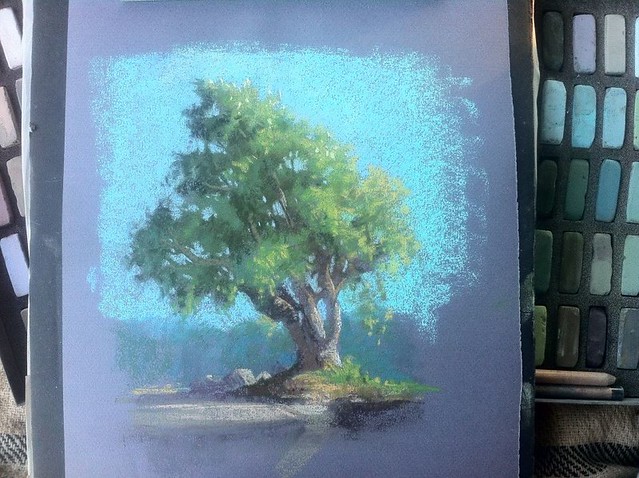
Tree on the bank of Lake Merced in the late afternoon, just off the side of the path near the parking lot on Sloat. Pastel, about 2 hours.
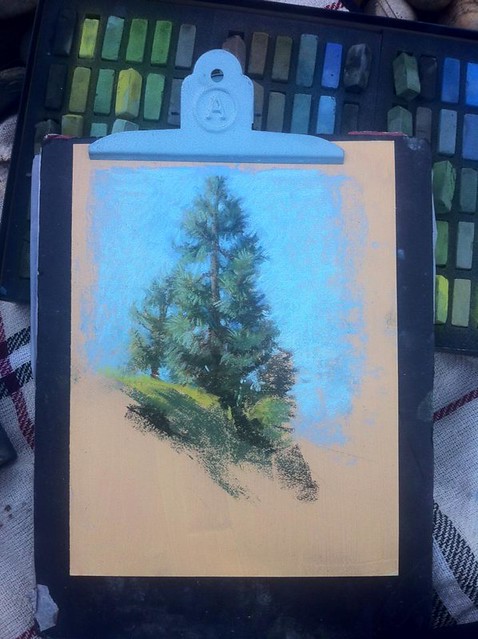
This was a majestic evergreen variety that I was looking up at from the parking lot at work. Not the best perspective to be painting at. I tried to compensate for the foreshortening but I'm not sure it worked. I also painted this on sanded pastel paper. I don't like sanded paper at all. It just grabs up a ton of the pastel pigment and is difficult to blend soft edges.
Pastel, about 2 hours
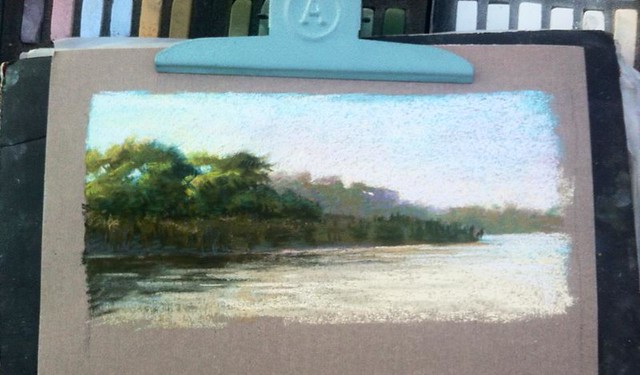
Found in the Minarets, Sierra Pack Trip
Earlier this month, I went on a fantastic six day painting adventure with artist friends
Eric Merrell and
to the Eastern Sierras - John Muir-Edgar Payne country. It was precisely the kind of uninterrupted painting time I so yearn for but don't very often get.
Lake Ediza was our destination, a steep hike up from about 7,000 feet to around 10,000 at the lake. As we hiked up from the Agnew Meadows pack station where we dropped off our gear for the mules to carry up, I was floored by the incredible views along the rocky trail as I breathlessly made my way up slower than my group, despite the conditioning/training I did a few months before the trip.

Our mule train arriving after a long hike up to Lake Ediza. Eric Merrell on the far right on top of a boulder.

I set up my tent just under a tree, situated rather close to our cook's food storage/prep area due to the view of the Minarets from my tent. Given that we had a 4:00 am bear visit to the camp site, I think in the future I'd place my tent much farther away from the food source. I'm sure the view was just as magnificent a little further away.

Zipping down the front flap to my tent each morning gave me the most amazing view! I did a few little pencil sketches from my tent in the mornings but mostly sipped coffee while staring at the mountains and feeling like all was right with the world. Probably not the most efficient use of my painting time, but deeply enjoyable nonetheless.
Before I went on the trip I planned out how I would approach the week of painting. I intended to sketch out a couple of long shots, a few medium and a couple of close up intimate scenes so that I could create a portrait of the area from large scale to the very small.
What I hadn't counted on though was how much the altitude seemed to factor into my experience within the first 24-48 hours. After we got up to Lake Ediza from a long and difficult climb up to almost 10,000 feet elevation, I found that even after a long rest and some water that my heart was beating quite fast. I tried my best to ignore it, but my worry distracted me and I didn't paint very well the first day.

After the first 24 or so hours, my heart slowed to it's usual pace and I felt pretty comfortable. Still, I decided to stay close to camp to further acclimate to the elevation. While my camp mates were hiking up steep terrain in pursuit of painting gargantuan landscapes, I crawled along a stream bed close by looking for miniature wildflower compositions.

I attempted several minute scenes, but these two are my favorites of the lot. Most of these tiny compositions were along stream banks underneath tree growth bathed in beautiful cool sunlight with reflected light bouncing in and deep warm shadows. The pastel set I brought did not have a yellow that was as bright and pure as the yellow I saw in the light, so I tried my best to layer a few colors together and tried adding some transition color along the edges in order to brighten the color.

I also had some fun playing with the outside edges of the compositions, layering blue and accenting the edges with an emerald green. These little compositions reminded me a lot of the kind of watercolor paintings I did a lot of in my 20's. I would really like to get some hot press watercolor paper and do some more of these little flower studies.
In keeping my goals, I decided to venture further away from camp in order to attempt a long shot landscape. I found a bank of trees at the opposite end of Ediza near to where we hiked in and made myself comfortable by the lake shore in a shady spot. I always enjoy large view paintings but do find them daunting at times. Part of the reason for this is probably technical on my part; I feel the need to hang out in one area until I get the entire area correct in terms of value, hue, and saturation before moving on to anything else. This I am sure is due in part to the lessons I learned early on at the Palette and Chisel via Richard Schmid, who often lectured about the importance of getting everything correct within the focal point first. It is entirely possible that I misunderstood his point, but still, there it is, imprinted on my art mind forever and the way I've approached painting since I was 19.
Bill must have wondered what the heck was going on because at one point he came up to me and said, "Commit Julia! Commit!" I had to laugh because I knew exactly what he meant. From that point on I told myself over and over, "stop the bullshit and lay in some more color!!!" I did find it helpful to stop lingering as much as I was in my focal point and get some more color down.


What attracted to me to this grouping of trees was the deep shadow within the bank of trees at the bottom. I liked the way the shape looked and liked how it was juxtaposed against warm and cool greens in the light. I'm not sure this photograph picked up the variety of color in the shadow very well, unfortunately.
Also, while I painted the mountain in the far distance behind the bank of evergreens, I noticed that the colors were muted variations of reds and greens, a color scheme I saw near the foothills of Zion National Park in Southern Utah. I wondered if these mountains have some of the same elements.
Switching to oil, I wanted to make a few studies of the light on rocks down by the water. I was attracted to the color in the shadows on the rocks - just jam packed with rich color that made it really fun to paint.

However, this simple study was more challenging than it might look. I'd look down to mix up some color, look up, and all of the sudden the temperature in the light was completely different! I decided it was probably due in part to the reflection of the shimmering light coming off of the water from Lake Ediza. This one is also on Arches oil paper. I layered the paint thicker in this study to compensate for the absorbency of the paper which seemed to make my values at least a full value darker about ten minutes after I laid down the paint.
I did another few studies of the Minarets but became frustrated with the oil paper.
I think I'll switch back to my usual L219 new traditions panels for oil studies.

Switching back to pastels, I decided to turn around, move down the beach and paint a close up study of this rock face and shadow. The rock had a blue-grey local color and in the shadow side had some oxidization that made rich brown patterns along the cracks. The entire time I was painting the main deep shadow of the rock I could barely wait to paint in those wisps of grass in the light. When I finally put those little lights in, it was like going to the circus!

I tried a longer view from across the lake. I had to work very quickly on this one since the shadow and reflected light was changing by the minute, it seemed. The triangle of shadow at the bottom was filled with cool deep greens while the shadows above had warm light bouncing into cool shadows.
The amazing thing about the Sierras, at least the Minarets and Lake Ediza, is the reflected light. I found it quite difficult to paint such bright bounce light in the shadows, always thinking to myself that no one would believe my painting if I painted what I saw in front of me. It was challenging to keep the reflected light within a value range that was in keeping within the shadow while also trying to define form. I've always found rocks and boulders challenging more so than other subjects for this reason.

I am so fortunate to have spent time amongst the Minarets with this band of talented mountain loving artists. What made it so deeply enjoyable was the kinship with fellow artists who were all equally enthusiastic about painting. As we sat around the dinner table while Kelly cooked we all talked about what we painted that day, the places we explored and the light we saw.

The light at dusk was just stunning, absolutely my favorite lighting of all, the time of day when all of the color is blanketed in a blue grey bath. Apparently I wasn't the only one interested in this; right after dinner each night, Eric Merrell would begin to set up his pochade box for some nocturne sketching. He had an excellent night time set up with little led lights on his palette that were perfect for illumination and did not blow out the light when you looked up at the dark scene in the distance.

Eric painting around 9:00. Although you can't see it in this photo, the moon was quite bright, illuminating the landscape and flooding it with warm and cool grey light.
I attempted a nocturne, but quickly learned that in order to do it well I needed a much better lighting set up. Every time I looked down at my palette with my headlamp to locate a color I wanted, I would look up and find my eyes completely unadjusted to the light making everything in sight a giant silhouette. I tried using a dim book light on my palette instead which was an improvement, but then had problems locating the colors I wanted to use. Below is my result, for better or worse.
However, I did indeed learn A LOT by making the attempt. Not only would I come with tiny LED lights like Eric's, but I'd lay out a limited palette ahead of time full of cool blues, neutral greys, and even warm greys and a few rich violets too.
The sky was so rich, full of violet and ult blue. I also vividly remember a thin sliver of very warm yellow value 2 light on the outer lighted edge of the moon - very surprising since the rest of the moon looked cooler in the light.

Besides developing a nocturnal lighting obsession, I became completely enamored by the lighting around waterfalls that were close to our camp. These areas were typically surrounded by rocks that when wet became a deep brownish color, almost black in some areas. This looked really stunning against the white water washing down around them and the green patches of vegetation nearby.

I felt like one day's time was not enough to study this waterfall area. I really want to go back and spend a full week exploring the light and color of this incredible dynamic.

Searle in America Auction, "Reminiscing"
Since starting my new job last year at Disney Media Group/Playdom, I've spent a lot of time sketching and thinking about classic Disney characters. It seemed a natural fit when the "Searle in American Auction" came around that I might try a theme with one of the villains.
***update: my painting on this post SOLD today! There are a number of new pieces by other artists that have been added and more coming - be sure to check the auction page!
After sketching a few ideas out of Searle's birds and cats, I just kept coming back to the concept of Cruella de Vil relaxing in her home office... I did a little research on wikipedia, and what do you know?!! Cruella did indeed go to school in England! Here is an excerpt from Wikipedia:
In the original story, Cruella is a pampered and glamorous London heiress who knows the owner of the Dalmatian puppies through school, though it is mentioned that they were not friends. Her net wealth as mentioned in The One Hundred and One Dalmatians £6 million. She was a menacing student with black and white plaits. She was later expelled for drinking ink.
Of course that school was St. Trinians!
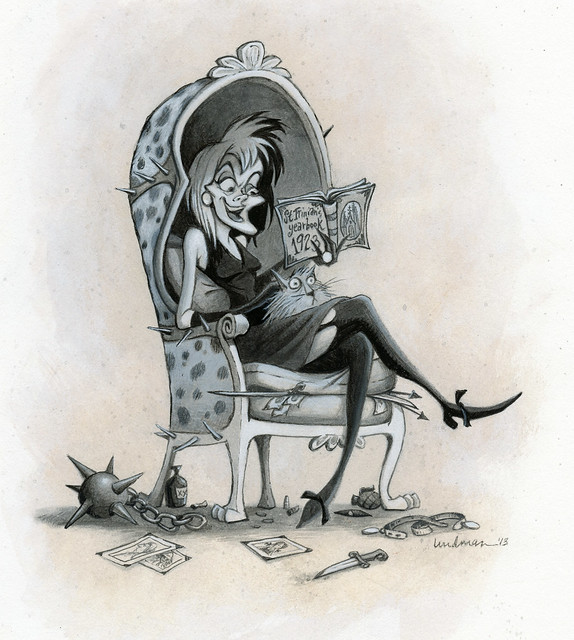
"Reminiscing", 10 x 12", gouache on board
************************************************
PROCESS NOTES
It's been awhile since I've painted something cartoony without a computer. These days at my job the characters, props and backgrounds I draw and paint are for pre-production concepts, so I don't often get to finish the art myself. I enjoyed researching Searle and his interesting line work and making an attempt at it myself, although I was light on the line work and more heavy on the values.
I thought I'd share a little bit of my process on this piece.

When I first thought of the concept of Cruella in her home office or study, I pictured lots of books, framed diploma on the wall, books on the floor as well as photos and other paraphernalia from her early days at St. Trinians. After sketching out several ideas, moving things around, and thinking about it, I decided that it was better to go simple with this idea. Since Cruella's face is looking down and so clearly the center of interest, I thought it better to have her looking into her yearbook. All else in the concept is support at that point, so I eliminated as much detail as possible, feeling the idea is stronger with less.
After I finished sketching, I found some good photoshop brushes and experimented with palettes. I looked at some of Searle's work and found that he often used an interesting blend of warm grey and cool blacks. I love the look, so I dug out some materials from my art closet to see if I could match his look in terms of color first.

I thought a base layer of tan acrylic wash would work well with cool and neutral grey gouache tones and a cool dark grey line.
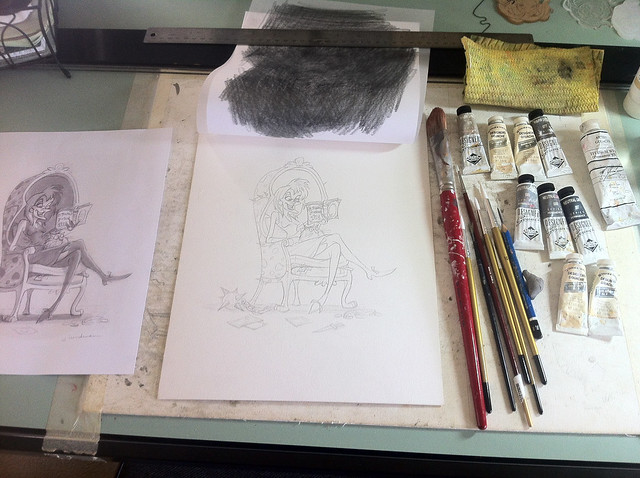
After I transferred the printed out drawing to a lightweight cold press illustration board, I painted a thin acrylic wash using the tan acrylic. This at first can be jarring because it tends to make the whole piece look dark and smears the lines a little, but when it dries the lines are in tact and the wash fairly clean.
After the acrylic wash was dry, I simply began to paint in flat values using the various grey gouaches mixed with a little titanium white gouache at times. I spent a lot of time fiddling with the layers, being careful to not let the gouache get too thick.

After I painted the grey tones I painted in the line work. This took longer than any other part of the rendering process, but was probably the most fun of all. In fact, I am now thinking about seeing what I can do with this technique on more Disney villains - just for fun!
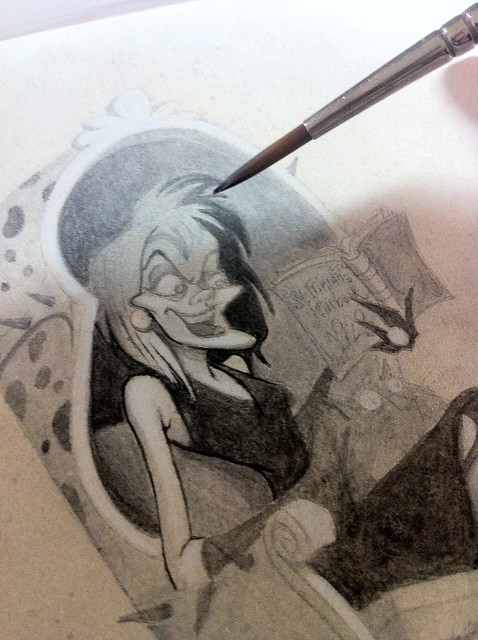
Please stay tuned if you have been following my posts on studying the Flemish Method with Sadie. I have finally finished the piece and will post about that VERY SOON!
Thanks for reading!
Little Museum Drawings and a Hiatus
It was an incredible experience to see Alphonse Mucha's works in person. Seeing a lot of his large format paintings and lithographs was absolutely worth the trip. His palette was far richer and varied than is conveyed in reproductions of his work. There were also a large number of sketches, many in mixed media, some in oil, and some in pencil and watercolor. All were amazing. Really amazing.
On this visit, I found this odd little sculpture that had an expression that intrigued me because of the intensity and the strangely slightly inwardness of his eyes. It made for an arresting sculpture that I quite enjoyed drawing.
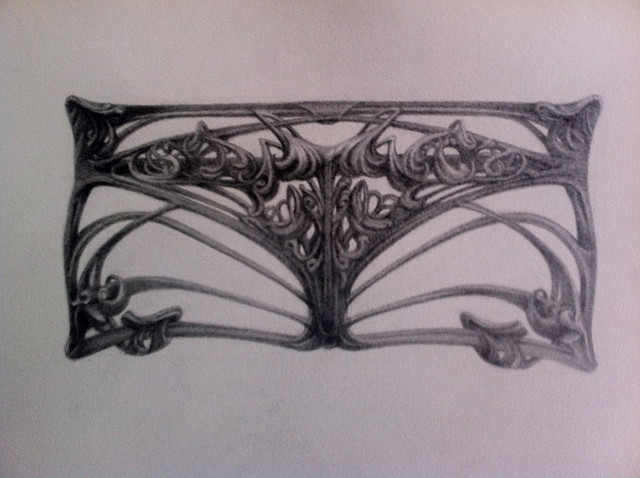
I have been collecting all of my little museum drawings on this magnetic chalkboard I have on my desk. They all remind me of some of the most magical times I have had with Jamie sketching together, probably some of the best times I've ever had with another human being.
Advanced Open Studio with Sadie/Part Five B
Oiling Out
Sometimes, when the oil is applied, it will bead up, which then requires wet sanding with very fine sand paper. It always makes me super nervous to sand my painting, but after having done it a few times now, I have found it actually great. The grain the sandpaper helps rid the surface of too many ridges (in Flemish painting an unwanted effect), dust, lint, odd streaks, and makes a really nice surface for the new layer paint to adhere to.
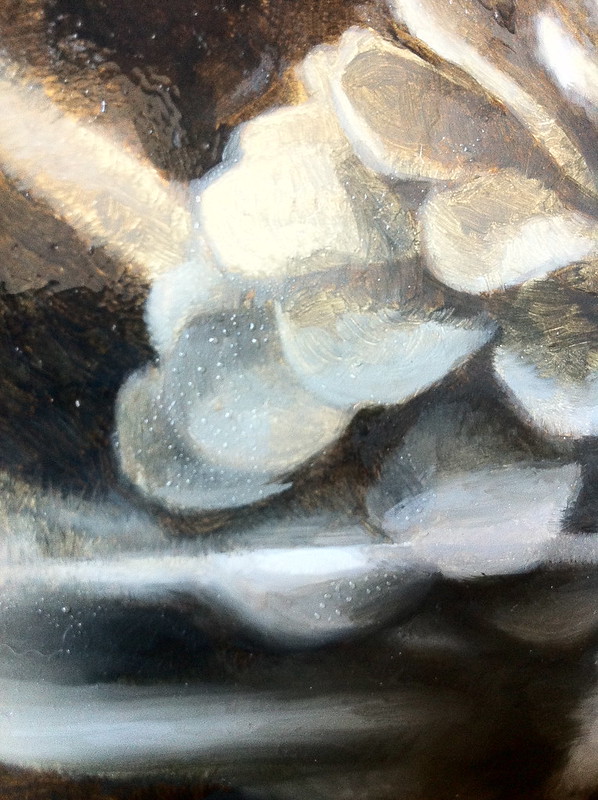
After I applied my "fat" painting medium on a portion of the surface, I used 1500 grit sand paper, moving in a circular motion. The reason for not oiling out the entire surface of the painting is because not only is it unneeded if only working on a small area for the day, but because over time those layers of oil, if put on too thickly, will slowly start to drip.
It also takes a few tries to figure out the thickness of the oil you like on your surface. It can't be too thin or too thick - somewhere in between that simply allows sanding and good flow of the paint.

Usually when sanding, some of the grisaille, especially in the white areas, comes up. I learned it is important to work more gently on the opaque white areas. Some paint will come up, and thus don't be alarmed as long as it doesn't ALL come up.
Once the sanding is completed, there will be a pasty texture. I wipe this off using a blue shop cloth (which has less lint than other brands) so it does not interfere with the layers of paint.
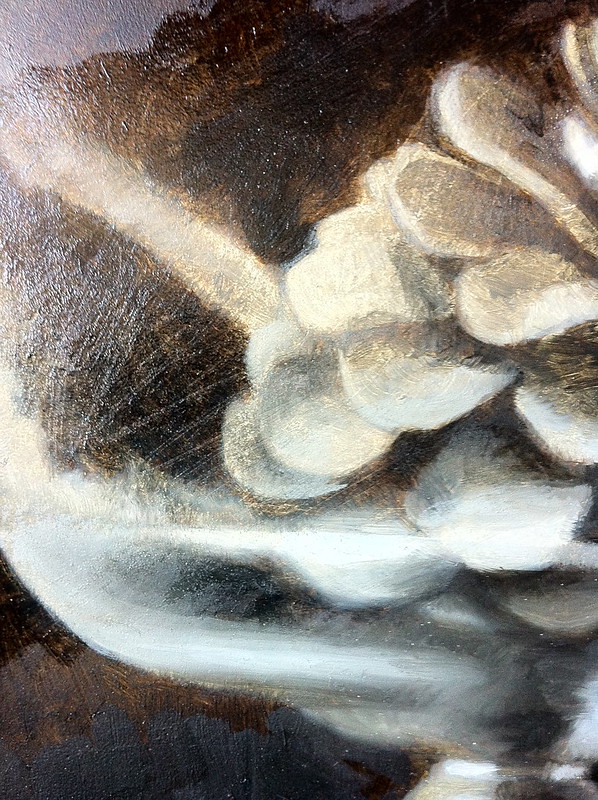
It is really important to sand only the area planned for that day. I had an experience during one of these sessions where I did not sand the entire area well enough. When I got to the un-sanded area, the paint would not adhere properly. I needed to wipe that paint off and re-sand.
Speaking of sandpaper, I recently bought several grades at an auto supply store. I bought 1000, 1500, 2000, and 3000 grade. From this point on (after my color block in layer), I will be experiment with these grades whenever I oil out, hoping to rid some texture and get a nice, smooth surface to paint on. I haven't yet tried these but I imagine they will help get of that maddening lint and small bits of dust that accumulate on the surface.
I also recently placed my mediums into "source" bottles so that I only use what I need for that particular day, pouring small amounts of clean underpainting medium and painting medium into small palette cups. Sadie does this as well. Having been taught to paint in the Alla Prima fashion, I had never explored mediums to this degree - hard to believe now that I know how useful and important mediums are.

I bought both the bottles and palette cups at Michaels Craft supply store. I am unsure how well these will stand up over time. If I notice any deterioration of the plastic bottles I will update this blog post and switch to glass.
********************************
Color Palette
For most painting purposes, these colors work very well in replicating just about any color and value. Painters always have strong opinions about what the best palette is, so you will find a lot of varied advice. I've tried quite a few of those variations but always come back to this basic set up. However, because I am familiar with the scope of the palette and have a ton of Rembrandt paints in my home studio, I've departed from the color palette slightly that Sadie recommends for class and added a couple of colors, specifically Transparent Oxide Brown, Transparent Oxide Red, and Pthalo Green.
Pthalo Green has always been a color I disliked for it's extreme staining power, but for some reason had a few tubes. I decided that since I would be painting a deep dark background for a still life subject that is mostly organic, Pthalo Green might be a good rich, powerful color when combined with Alizarin Crimson and Burnt Umber. So far I haven't been disappointed.
The palette I am using is as follows (a slight departure from Sadie's recommendations):
Yellow Ochre Light (Rembrandt)
Cadmium Orange (Windsor Newton)
Cadmium Red (Rembrandt)
Alizarin Crimson Permanent (Gamblin)
Terra Rosa (Windsor Newton)
Transparent Oxide Brown (Rembrandt)
Pthalo Green (Rembrandt)
I have added a couple of Windsor Newton color simply because I had them. Otherwise I do not prefer WN brand oils, finding them mostly filler. Rembrandt makes nice colors that I like, however I am annoyed beyond end by the tubes being too difficult to open.
After I use up a little more of my paint stock, I plan to drop Rembrandt paints and replace them with Natural Pigments, finding the pigments far superior. (I will probably write about this at a later date.)
Color Strings
In all the years I've painted, whether it be in gouache, watercolor or oil, I have never made color strings. If you are unfamiliar with the term, a color string is simply mixtures of the main colors that you can identify in the set up. Color strings for me have been a "why didn't I think of this sooner" sort of an idea, so obvious!
Sadie always instructs us to mix up color strings of the basic colors from light and dark in the area we are working on that day. This helps to focus on a specific area without having to spend too much time figuring out color on the fly. Part of what interested me in this subject was the close chroma range between the pine cones, the wood base, and the twigs. Mixing up the color strings on this subject has been fun and challenging.
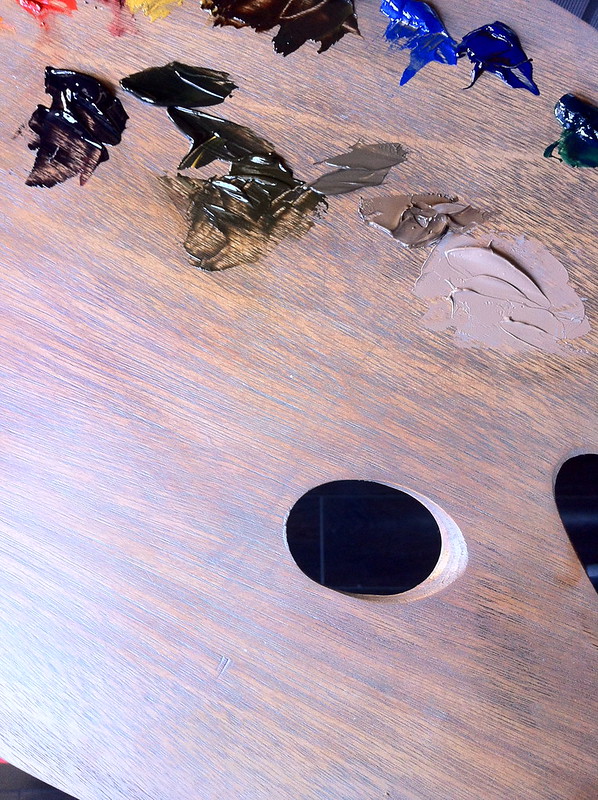

On the palette (below) you can see the slight difference between the cool dark (lower left) and the warmer, more reddish dark (upper right). Although both are a close to a value 10, the vibrancy of the color is very apparent on the painting next to one another. If I had made these two colors the same, the painting would far less depth in the final result, especially after a final coat of varnish.

After I painted the green of the cloth in the lower left and part of the tree base, It was easier to judge color in more difficult areas like the glass and the bright greens of the lichen on the sticks behind the pine cones.

Sadie instructed me to paint difficult and detailed areas "blurry". The reason for this is because in later stages I can decide how detailed or non-detailed to make these areas. If I had painted these areas too finely in this stage, they would be more difficult to soften later.

Most of the chroma in this stage, the color block in, errs on the side of higher, warmer chroma rather than lower, cooler chroma. Sadie said that it is far easier to later bring the chroma down than to bring it up from a cooler state. Therefore this entire color block in is warmer than it appears in reality.

One of the most interesting things about this process is how Sadie stresses how soft and blurry everything should be. The reason is because at the next stages, the finish, we will work on selective focus, what areas to choose to emphasize, and what to let fall away.

The two above photos demonstrate how blurry and out of focus to treat very detailed areas like this twig that is covered in lichen. Sadie said it was better to paint these areas as larger swatches of paint in one pass rather than focus in on the minute nuances of each string of lichen. Once the main color of the lichen is established, I can later go in and define detail.
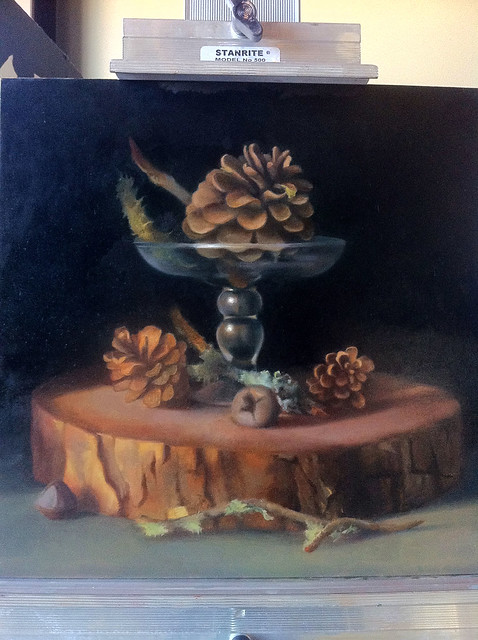
The finished first color pass.
Note that the highlights on the glass are treated generally rather than specifically and are much larger than they are in life. These will become closer to reality in subsequent stages.
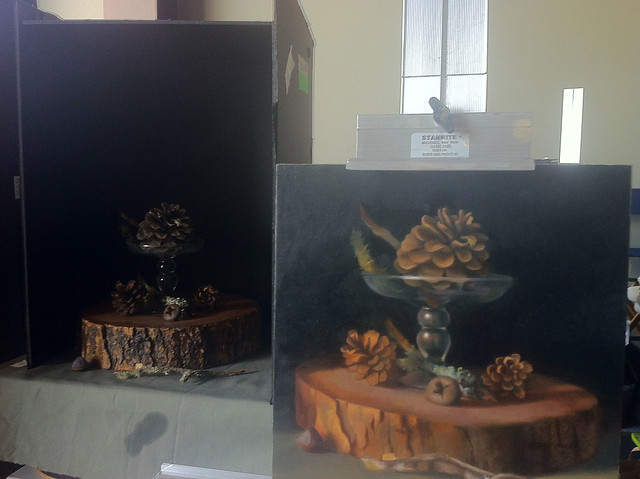
The color block in took me about 24-30 hours total. I am only painting on Sundays, so this is over the course of a few months.
Please stay tuned for the final stages of this painting. For the finish, I will be posting more often and adding to an album I have created on Facebook.
I hope that by sharing my progress and class notes, you can find some new information for your own paintings that helps.
Thank you for reading! :)
Learning about Color
A Lucky Charms commercial pan background I painted in gouache on illustration board, approximately 3 ft. x 14" wide, around 1994
"Lillies", 11x14, gouache on paper, 1992
But working from imagination alone, I believe, is not effective unless an artist works also from life. One tends to inform the other. During my years in Chicago, I regularly painted the still life, figures and portraits from life over at the Palette and Chisel, which helped me to develop a sense of how to mix paint, see color, simplify it, and apply it on canvas. I learned from Richard Schmid the principle of "cool light warm shadows, warm light cool shadows", something entirely new to me at the time. It was there that I learned how critical value relationships are to color, and how important it is to keep your color clean. Interestingly, I also learned from painting the figure and still life how it seems the majority of colors in any given subject seem to be more greyed down that I usually think at first, and how few really true high chroma colors are usually present.
Later on, when I needed to switch to painting in Photoshop at work, the Munsell Color System in the program gave me a way to visualize how connected the relationships are between hue, chroma, and value.
After having these experiences, I believe that learning about color is not simply the study of one component like a color wheel or color charts. I believe it has to be a combination of methods plus a relentless pursuit in training your mind to see and translate color accurately. I am still learning and sharpening my color and values sense, and hope that by making another concerted push now in my life I might break through a plateau I've been experiencing the past few years. By documenting my experiences and writing down what I know plus reading new research and methods while also painting from life, I hope to make some improvements.
********************************
Learning to Mix Color
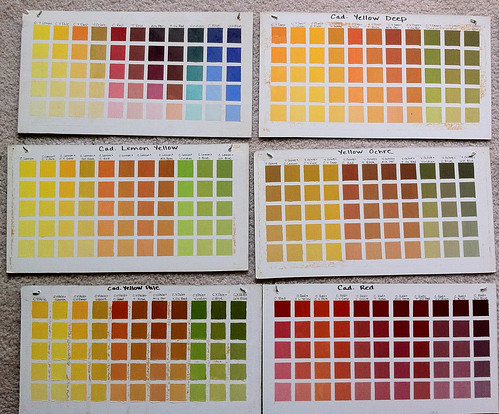

********************************
Learning to Identify Color
********************************
Tools to Understand Color
hue: the local color of the subject
Another useful visualization of the Munsell Color System is the way that the program Adobe Photoshop represents it. Photoshop has an excellent color picker that brings up a color wheel. However, I prefer to use an enhanced extension called Magic Picker, an excellent color wheel for Photoshop used by many professional digital artists. If you have a copy of Photoshop, open up the program and experiment with painting swatches using the color wheel. Playing around with the sliders and adjusters really helped me see how color works using this system. This is the same chart depicted above, but represented differently.

Adobe published a technical guide regarding the Munsell Color System. You can find it HERE.
For further reading on the color wheel, read James Gurney's "The Color Wheel" series, Parts 1-7 on his blog, Gurneyjourney.blogspot.com. Gurney has a different but related approach culminating from his years of research on the color wheel. Excellent information, worth the read, including the comments.
Artist Graydon Parrish teaches a three week workshop in using the Munsell Color System at the Grand Central Art Academy in New York City each summer. The usefulness of learning the Munsell Color System is that it can help any artist identify any color, and use that color to depict anything he or she wishes. It is complex to understand at first, which requires some study and practice. I hope Graydon continues to teach - his classes are on the top of my list to attend!
Here is how Parrish describes the way he determines color in his paintings:
The above is just the beginning. One can analyze, then translate so many effects of nature into paint. I have a photo of a Bouguereau drawing where he had written the various colors of his model: green-grey, yellow-grey, rose-grey etc. With Munsell, the notations can be much closer. No more vague terms. (How much grey, for example, is in green-grey?) Its better to say 7.5 YR 6/3 or 7.5 R 5/4, for the average flesh and the ruddies. Then with mixing and planning, one can create an entire palette of Bouguereau flesh, for every change in value, and predict the rise and fall of chroma.
Likewise, Paris Hilton, could be studied and painted as well in all of her sun-tanned splendor. She is likely a chroma 5. When you then know where the chroma rises and where it falls, why some colors pull yellow in the lights and others don't, and how various transparent objects are more chromatic on the edges, then you have the beginning of an entire repertoire of visual phenomena from which to create." - quoted from the wetcanvas.com forums, HERE.
How Color Behaves in it's Environment
In addition to studying the Munsell system, learning how to mix and identify color, it is critical to also understand the principles of light and how color is affected by it. Matching color in any given subject is an important skill in developing the eye to see color correctly and helps to determine your palette and pigment choices. However, also understanding the reasons that make color appear a certain way in a particular situation is equally as important.
The very best books I can recommend are:
Carlson's Guide to Landscape Painting
Andrew Loomis, Creative Illustration
James Gurney, Color and Light
Richard Schmid, Alla Prima
Here is a summary of some important points I learned from these books about how light and color work together:
- cool light produces warm shadows; warm light produces cool shadows. (Alla Prima)
- the most saturated color in a particular area is at the transition between the light side and the dark shadow and also at edges of objects. (Color and Light)
- Values in a landscape are often as depicted below, the source of the light, the sky, most often (even at night) being the lightest value in the landscape, the ground plane the second, slanting planes third, and upright planes usually the darkest. (Carlson's Guide to Landscape Painting)
- Value is the most important factor in a painting, with hue and chroma coming next. If values are correct, hue and chroma will still be able to read. (Color and Light)
- a color will alter it's appearance depending upon the context of that color in the light or if other colors around it change. (Alla Prima, Color and Light)
- the limitations of pigments prevent us from depicting the wide range of luminosity in the world around us, so we must make adjustments in order to get across an approximation of what we see. (Alla Prima, Color and Light)
page 34, Carlson's Guide to Landscape Painting by John F. Carlson
In "Creative Illustration" by Andrew Loomis, he dedicates a chapter entirely to the great Howard Pyle. Loomis included this chapter in order to pass on directly, in print, information that was taken in note form during classes taught by Pyle regarding his general theory regarding light and color.
"All objects of nature are made visible to the sight by the light and of the sun shining upon them. The result is that by means of this we see the colors and textures of the various objects of nature.
From this it may be seen that color and texture are the property of light and that they do not enter the property of the shadow. For shadow is darkness and in the darkness there is neither form nor color.
Hence form and color belong distinctly to light. Shadow - as the object illuminated by the sun is more or less opaque, so when the light of the sun in obscured by that object, the shadow which results is more or less black and opaque, being illuminated only by the light reflected into it by surrounding objects.
By virtue of shadow all objects of nature assume form or shape, for if there were no shadow all would be a flat glare of light, color and texture...But when the shadow appears, the object takes form and shape.
If the edges of an object are rounded, then the edges of the shadow become softened; if the edges of an object are sharp, then the shadows is correspondingly acure. So, by means of the softness or sharpness of the solid object, is made manifest.
Hence, it would follow that the province of shadow is to produce form and shape, and that in itself it possesses no power of conveying an impression of color or texture."
A Plein Air Summer, Going with the Flow
This summer I left my job at games company Zynga so that I could accept a new job as Art Lead at Disney Interactive/Playdom, a position I am very excited about. In between jobs I had a month off, time I sorely needed and, of course, I used that time to paint.
and I had tickets to attend an event called
, a traveling chef tour that was hosting a dinner at
Farm Fresh to You in Capay Valley
. We booked the whole weekend with the idea of wandering around the valley sketching idyllic rolling hills and farm country.
Tragedy struck on the first morning of the first day when we witnessed a terrible murder of a cute baby faun by a Labrador retriever. After seeing such a beautiful little creature murdered by the neighboring farm's family dog, I really didn't feel inspired to sketch the landscape. Since we still had three days and our fancy chef dinner wasn't until the last night, we wandered around the valley looking around for sketching spots. Somehow, nerves-of-steel-Jamie was able to concentrate, but my mind was completely shattered. Finally on the morning of the third day I asked Jamie to find a spot he liked. I resolved that what ever it was, I would force myself to paint - no matter how I felt. He had been eying some old trucks by the side of the road, so that's where we set up.
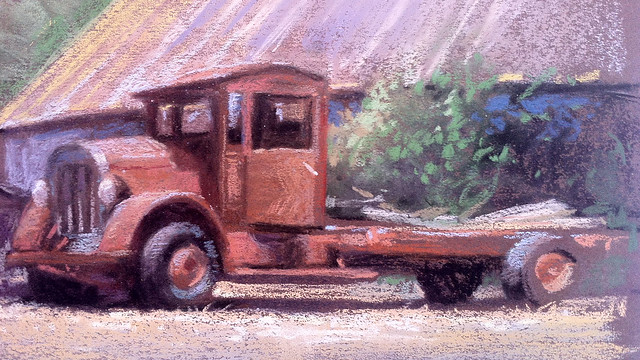
"Old Truck", 8x12, pastel on toned paper
What a challenge...I found the first hour was the most difficult. Maybe because I'm not an old-rusty-truck artist, I found the subject sort of interesting and different. That was enough to suck me into it, trying to find the correct placement of angles and figuring out the lighting and color shifts. Eventually my mind started to float away from those images of violence and into another world,
flow
.
Later that night we went to the Capay Farm dinner that was hosted by the "Outstanding In the Field" group. We listened to a great lecture by the owners of the farm and also by the people who run the chef tour about supporting organic farms. It was pretty great and so different from anything we've ever done.


The entire time we were at this event, I was salivating over the GORGEOUS light all around us - and these photos certainly do not do it justice. I wanted to freeze frame so many moments and paint them! Alas, those images are locked in my private data base for future inspiration.
The very next week Jamie was working in LA. I flew down to Santa Monica the following weekend, where Jamie and I spent our entire Saturday and Sunday exploring the beach and sketching.


and also some time relaxing in the sun!

Although I tried both days to paint the Santa Monica boardwalk, I was not successful in capturing what I saw. The light was shifting so quickly, almost moment by moment! Trying to figure out what to focus on was my biggest concern. I really love touristy sites with all their bits of busy color and activity. I would love to come back and do an entire series of sketches of this subject and other lighting conditions I observed on the beach.
After that experience, I realized what I needed to do mentally and physically during this
rare
month off from work - I needed to focus and get some paintings done. When I think back on it now, I have not had a month off since I was 20 years old in college. Since then, I've worked full time every single day with just a few weeks off for vacations here and there. I've never had time to explore a particular subject or a concept in a series or do very large works - something I am
itching
to do. A month off from work certainly is not a lot in the big scheme of things, and at the same time, incredibly precious to me.
With that in mind, I decided to rent a hotel room up at Lake Tahoe by myself. All I brought with me were my backpack,
, paper to draw on, my horrifying paint box and too-heavy tripod, my camp chair, painting umbrella, a book on John Muir meditations, flip flops, bug spray, hygiene necessities, my iphone, and some painting clothes.

"Lake Donner Sketch", 8x10, pastel on toned paper
Actually, I forgot to mention my family was visiting too, staying at a rented house in Truckee. I really didn't paint during that time. Instead, we did all sorts of cool things like kayaking, hiking, hanging out, and watched the Olympics. The only sketch I did do during my family's visit was this one, above, about 1 hour.
Ok, so I was a total loner AFTER my family left. I rented a cheap hotel room in Tahoe City, with the goal of completing one painting per day. That's right, only one painted sketch per day. Although I can if I have to, I am not crazy about fast sketching. I like to find a spot I love and spend a full 4-5 hours to record what I see. My goal here was to really get in there and study the light, get everything working together rather than an abbreviated sketch. Too much of my life already consists of half completed thoughts and quick sketching; I simply had the urge to complete full thoughts and go at a slower pace.
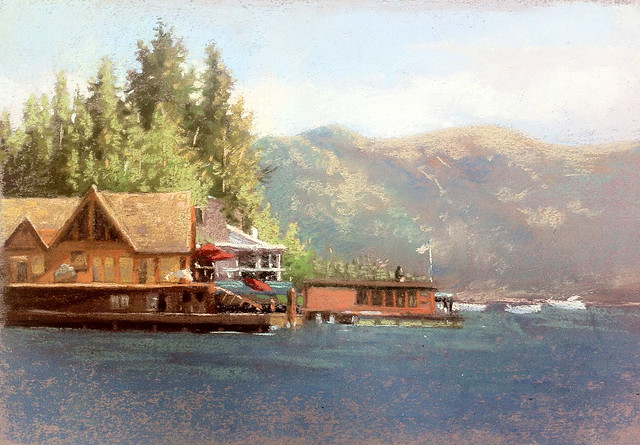
"Tahoe Vista", 10x12, pastel on toned paper
What attracted me visually about the coast of Lake Tahoe was the surprising juxtaposition of the earthy palette of the mountains and lake against the extreme saturation of summer time water sports, outdoor cafes, and boats. Again, I found myself gravitating toward touristy sites full of tiny bits of saturated color.

After painting a few busy spots, I ended up at the AMAZING Sand Harbor. Everything about the place was so incredibly beautiful that I ended up coming back for several days, completely floored by the color of the water, the rocks, the sand, kayacks, and stand up paddling, while also impressed by the cafeteria, well maintained public bathrooms, food stands that served fish tacos and pomegranate margaritas, AND an outdoor theater that performed Shakespeare plays
nightly
!!!
This beautiful rock formation was littered with kayaks, boats and swimmers when I began the sketch, but after a mid-afternoon nap I woke to find everyone had left. I like the solitude of the rocks and the amazing blue-green hue of the water at this beach just as much with the swimmers as without.


"Sand Harbor Rocks", 8x10, pastel on toned paper

A little about my plein air set up:
it is ridiculous.
I am never that comfortable standing and painting, and even sitting on a camp chair and painting. After trying lots of variations, I finally found that if I attached my umbrella to my camp chair, placed my purse on it as a weight and then used my backpack as a cushion to sit on and propped my pastels on my paint box, I was magically able to concentrate more deeply. Finicky, I know...
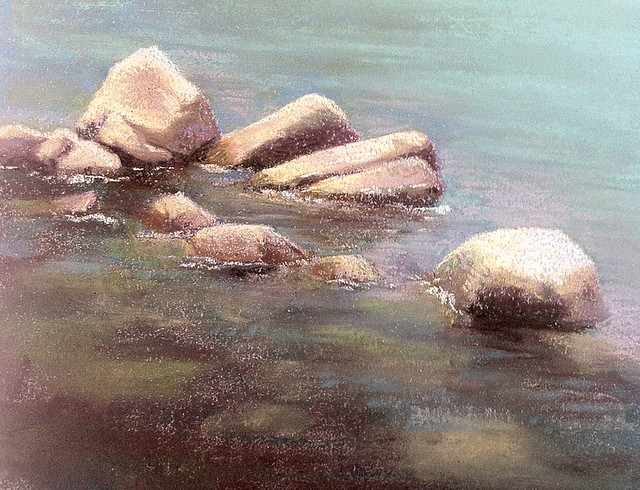
"Sand Harbor", 8x10, pastel on toned paper
After having such a nice time at Sand Harbor, I searched around for subjects that contained no evidence of human activity, especially given that I had just experienced several days of people peeking over my shoulder and asking me questions about what I was doing and why. I finally found a seemingly perfect spot along the rocky shore line that I had to climb down pretty far with my set up. At 8:00 in the morning I had no way of predicting that by noon a steady stream of people would be climbing down the rocks right in front of me trying to get to the water all day. But as anyone who paints outside knows, there is
always
a surprise or some difficulty and you just have to go with it.
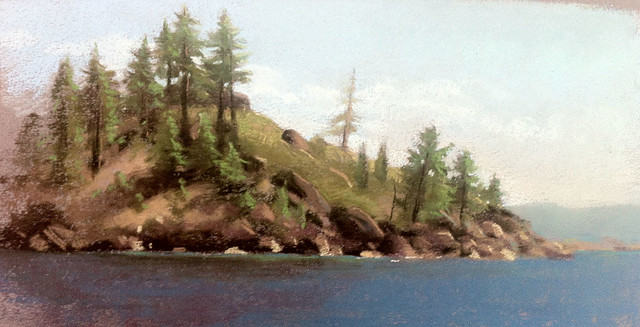
"Tahoe Shoreline Overlook", 8x12, pastel on toned paper
Fortunately there were moments of uninterrupted solitude at other locations.
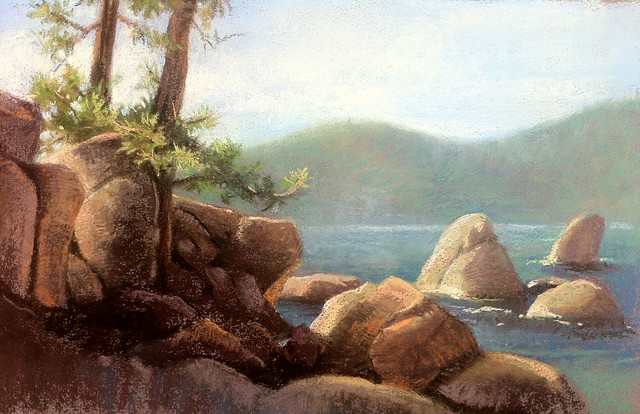
"Lake Tahoe Shore", 8x10, pastel on toned paper

"Vikingsholm, Lake Tahoe", 8x10, pastel on toned paper
After a week of bliss painting and long walks at night thinking about all of the future paintings I would like to do, I returned to San Francisco and the endless summer fog. Not feeling super inspired to paint city scenes, I spent a little time in the DeYoung looking around, trying to regroup. I found this great little painting tucked away in a quiet corner of the museum by Jefferson David Chalfant (1865-1931), entitled "Bouguereau's Atelier at the Academie Julian, Paris, 1891".

Jefferson David Chalfant (1865-1931), entitled "Bouguereau's Atelier at the Academie Julian, Paris, 1891"
I also went outside the museum and looked at some fantastic sculptures by
, whose sculptures appear all over San Francisco. Oddly, all of these particular sculptures are in cages. I am unsure of what the reason is for putting these in cages. It is unfortunate since the sculptures are well executed, although a bit...odd, children wrestling giant rabbits, lions fighting with goats, and dogs attacking a kangaroo.


Despite the cage, I tried to sketch "Greyhounds and Kangaroo". I am certain I did not capture the gesture well; to me this looks a bit jumbled. My only defense is that the subject matter brought back vivid memories of the violence we saw a few weeks earlier in Capay Valley.

"Greyhounds and Kangaroo sculpture by E.M. Cummings, Golden Gate Park", 8x10, pastel on toned paper
While I sketched, I thought about this subject Cummings chose to explore - animals fighting, one being at a clear disadvantage. I also thought about a Richard Dawkins essay I read earlier in the year regarding deeper aspects within the theory of evolution and survival of the fittest.
Apparently, survival of the fittest does not necessarily mean the strongest vs. the weakest, although that dynamic does play a part. Survival of the fittest also means the advantage of being flexible, of being a species that can "go with the flow", absorb and adapt. I think that concept can also apply to painting. Painting is hard. It takes a lot of practice, a lot of time, investment in education, money to buy supplies, and hard work. It is difficult to get all of those things working together and can be frustrating and easy to internalize, creating a mind environment of "I am not talented". I believe the true key to what we regard as "talent" is really quality education. This for many reasons is difficult to access, and when accessed requires a lot of time to practice. However, it is during those moments of doubt that I need to remember:
I am doing as much as I can possibly do! take a deep breath, and go with the flow!
And go with the flow I did. It's been a few years since I've plein air painted in oils, finding it frustrating and not really getting good results. Even so, I decided, what the heck, I've got some time, why not try again? I headed over to the Conservatory of Flowers on a very cold and foggy day to paint this building I've been intrigued by for a long time.
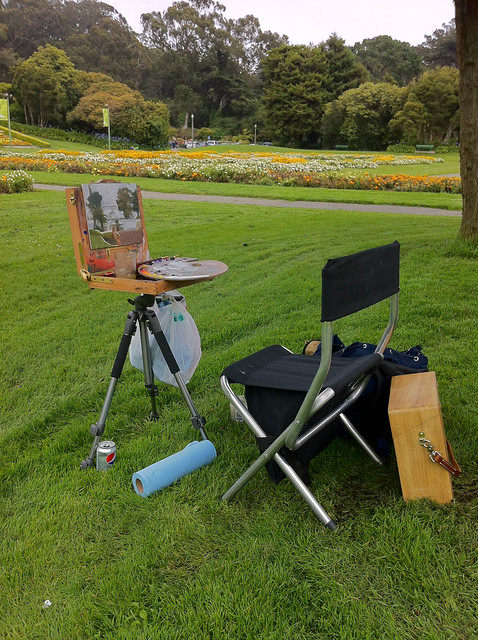
NOTE: I do not at all recommend using a hand held palette on top of your plein air box, unless you are finicky about your set up like me. I like the hand held palette because I have access to the entire surface as opposed to a palette that is set inside a box. Open Box M has a shallower palette surface, so I plan to purchase one soon.
It took me an entire day to figure out the color range of the building and contemplate the drawing challenges involved in this building. When I recently took a perspective class taught by Carl Dobsky, he mentioned that he would do a field sketch of a subject and then recreate the perspective in the studio before doing a larger more formal painting. I had that in mind when I was painting this, so I tried my best to get an impression of what I observed, painting only the most important information and not worrying too much about correct perspective - which is difficult to freehand on a subject like this.


"The Conservatory of Flowers, Golden Gate Park", 8x10, oil on panel
Although this is my first study of this fascinating building and great lighting conditions, I plan to paint some more studies from different vantage points and explore some larger compositions. I hope to take this to the next level by creating a large painting using the method of perspective recreation that Carl Dobsky taught us in class.
"Aboriginal Art is described as a method for gaining knowledge of Nature and it's invisible dreaming".
Painting in Golden Gate Park in the foggy and cold summer is always interesting more for the people within the park than anything else. While I painted the conservatory, a man set up about 50 feet away from me and began playing a didgeridoo, an incredible Aboriginal instrument from Australia. How amazing it was to paint while I listened to this incredible sound!
I also tried at least twice to paint the fantastic Dahlia Garden and failed miserably, I still felt ok.

I did not group together my lights and darks cohesively and instead created a complicated light pattern that does not read well enough.

Jamie painting along side with me in the Dahlia Garden. :)
Sorry for the Delay
Advanced Open Studio with Sadie/ Part Four
Closed Grisaille
The purpose of creating an under painting is to bring the values, (the black and white tonal range) of the subject closer to reality. Sadie described it to me as becoming 50% closer to reality with each successive layer that we work on. In the first layer, the open grisaille, we broke down the shadow vs. light areas. In the second layer we make a full value opaque tonal painting, which acts to prepare for the color layers and, in addition, aides in creating luminosity and softness in the color stage.
From Adrian Gottlieb's online glossary: "Underpainting: Also called dead coloring, under painting was once one of the most commonly used techniques in oil painting but fell into almost total disuse among contemporary painters.
Historical
During the 12th through the 13th centuries and possibly earlier, grisaille painting was used in stained glass mainly as a decorative addition to the colored glass. Some grisaille painting was also used in narrative panels in churches throughout Northern countries such as France, England, the Netherlands.
French; Paris, from the Chapel of Saint-Louis, north aisle, royal abbey of Saint-Denis
Pot-metal and white glass, silver stain.
At this time, grisaille was also used in the southern countries of Europe in plaster fresco painting to imitate bas relief sculpting in everything from churches to civic buildings, particularly in Italy.
Later, grisaille was used by many of the 19th century French academic painters, like Ingres, as in the example below, who were intrigued by Flemish painting methods.
Jean-Auguste-Dominique Ingres (French, 1780–1867)
Today, many modern Realist artists also make use of the grisaille. It can be beautiful in and of itself; some artists use a combination of grisaille and glazing. For study purposes it is a useful method for training the eye to see value ranges, and is often taught for cast painting and figure painting in a classical ateliers. Check out this link for a beautiful Colleen Barry partially painted closed grisaille with the open grisaille exposed underneath, HERE.
Method
Recipe: 2 parts linseed, 1 part odorless turp
Use either Turpenoid or Gamesol brand Odorless Mineral Spirits. There are many linseed oils available.
************************************
Value String
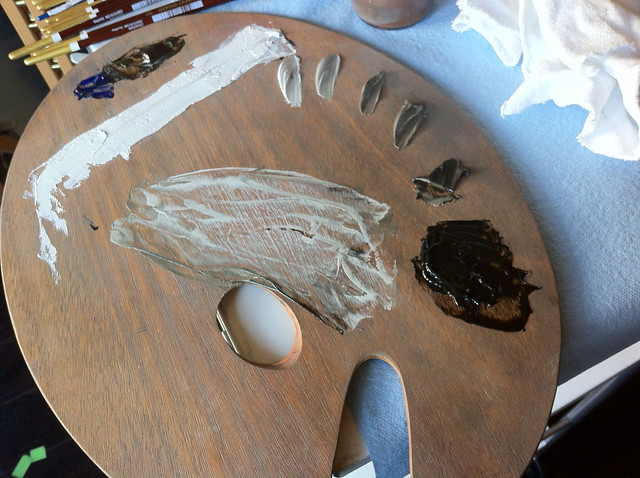
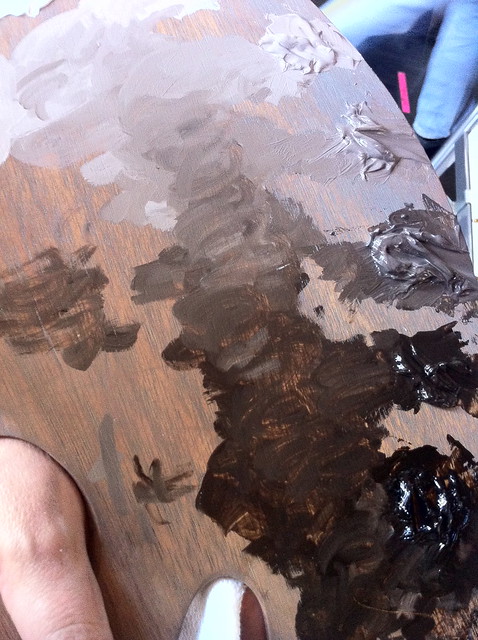
************************************
Technique
***note: There is an unfortunate glare on some of my photos due to very strong light in the studio. Hopefully you can get a general sense of the scene. I will try to improve my photos for the following posts.
I didn't really know where to begin, so I started on the easiest, the very dark, almost black background against the lighter pinecone, which is the focal point of my painting. The two sticks that move into the dark area are covered with lichen and heavily textured. Sadie instructed me right away to paint these almost blurry, soft and to avoid all detail, focusing only on the general effect of the value on each area against the black background.

In my last post I used the underpainting medium more often, dipping the edge of the brush into the medium and then sopping up the excess with a paper towel. In this stage, it is not necessary to do that since the paint will be opaque. The point is to get the paint to flow off the brush and on to the panel, but not have it so fluid that it is transparent and drippy. Most of the time I did not need more than a tiny bit on my brush. Once that bit was mixed into my paint as I worked, the paint seemed to be fluid enough to continue to work for quite awhile.
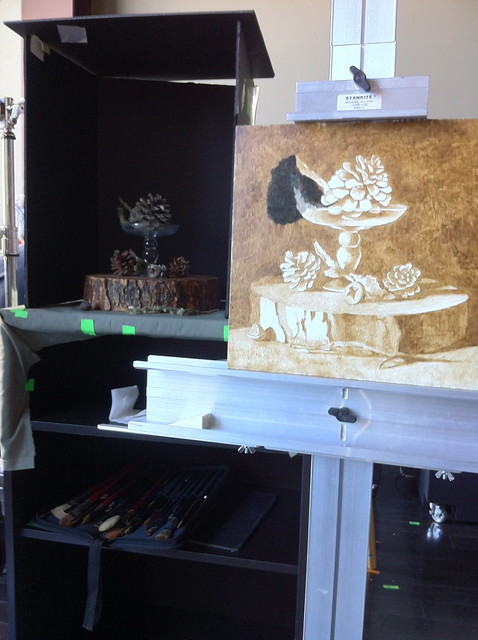
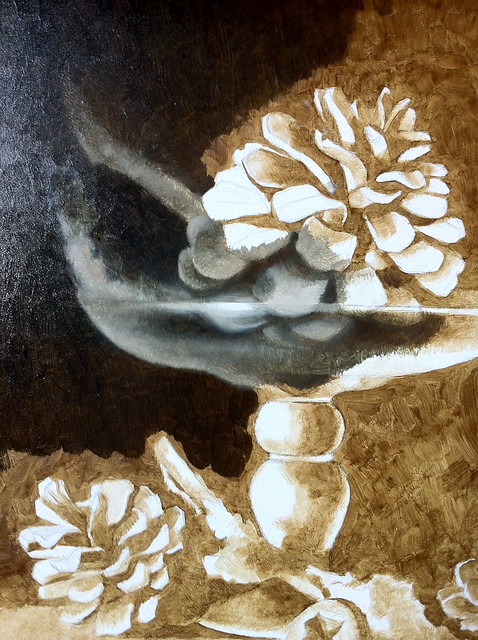

************************************
Next Session
The highlights on the glass piece are in reality MUCH smaller than they are depicted here. Sadie instructed me to make a large "glow" around the highlights, blurring out the edges so that in later stages I can work up to making the highlight soft and luminous, working up to the point of light rather than dotting on opaque paint.


It is difficult to leave the highlights so large knowing they are not like that in reality. They jump off the panel every time I look at this underpainting, forcing me to be patient for the subsequent layers.


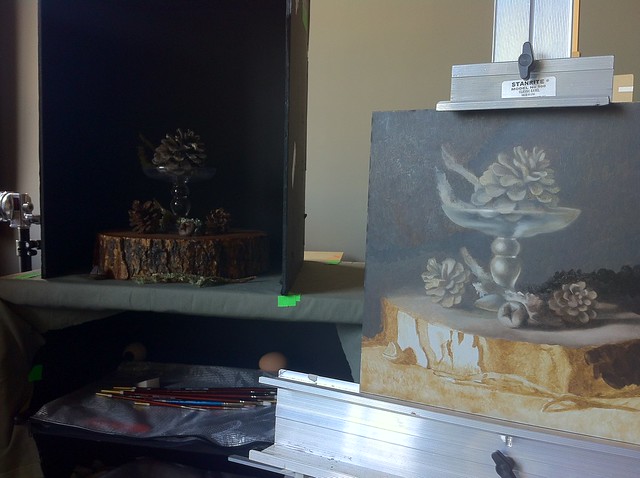
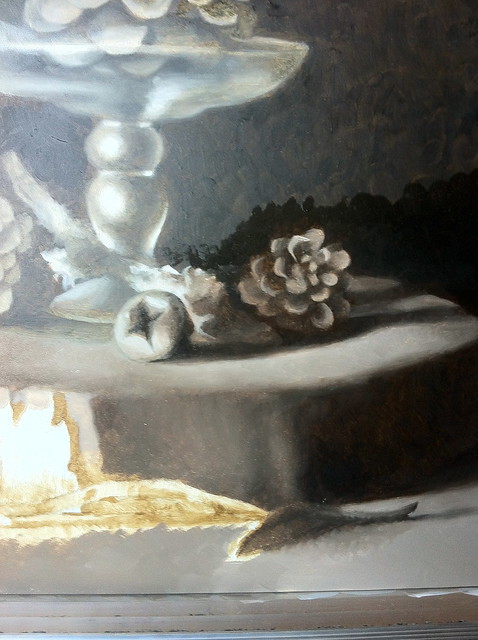
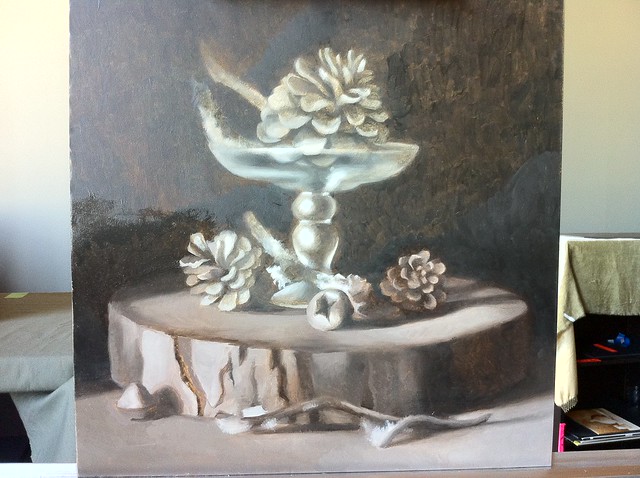
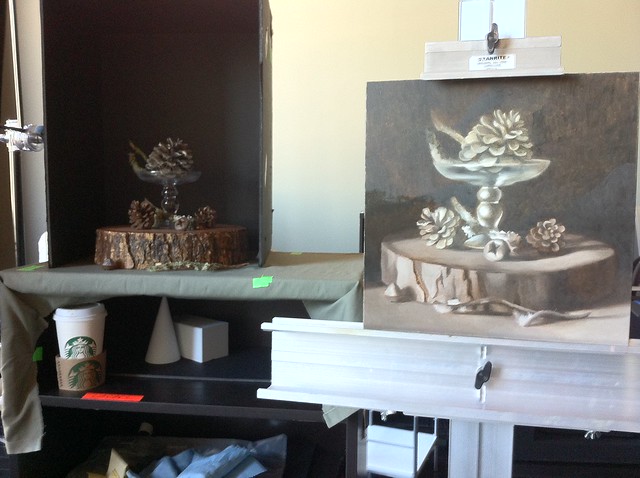
**********************

















